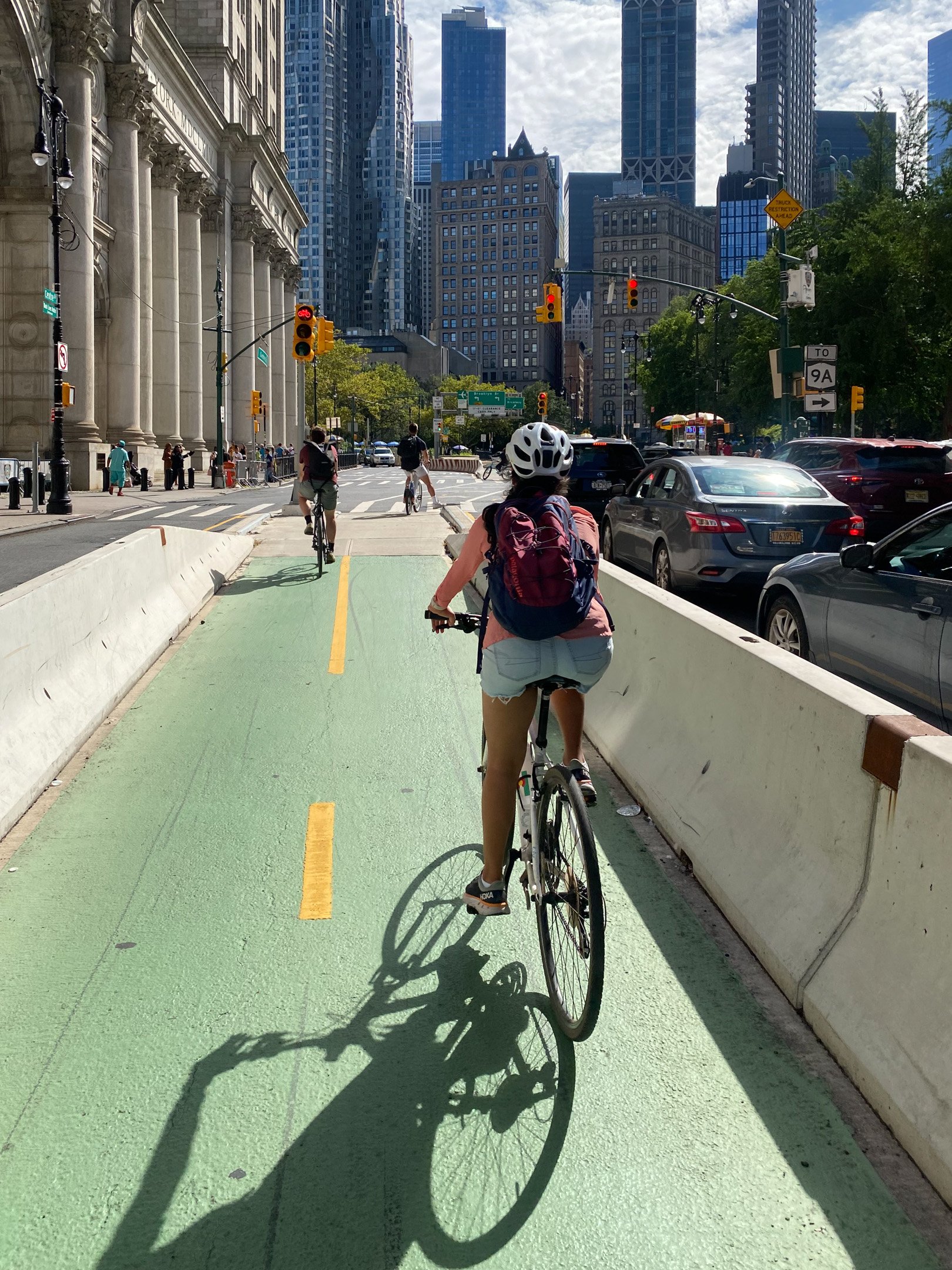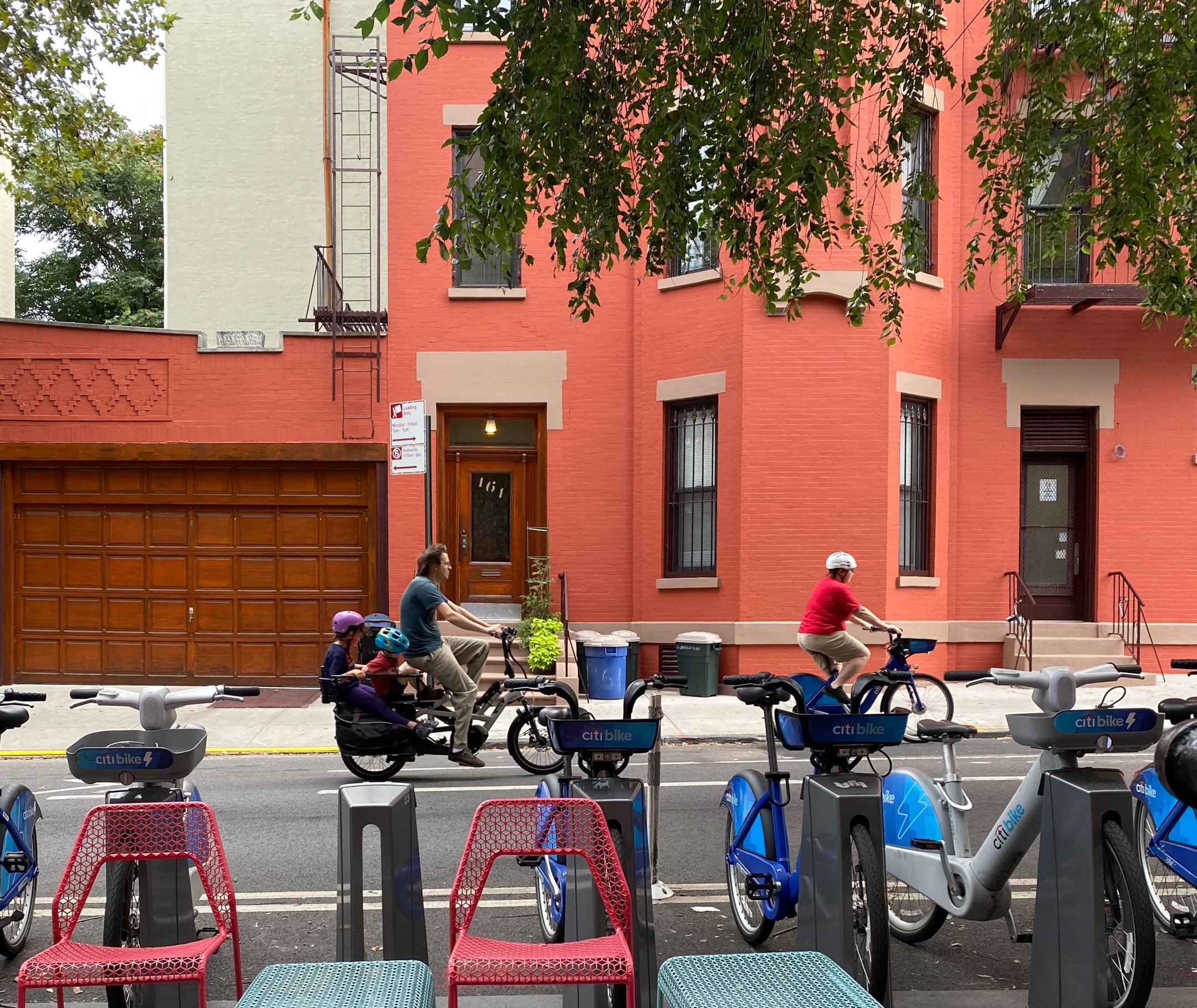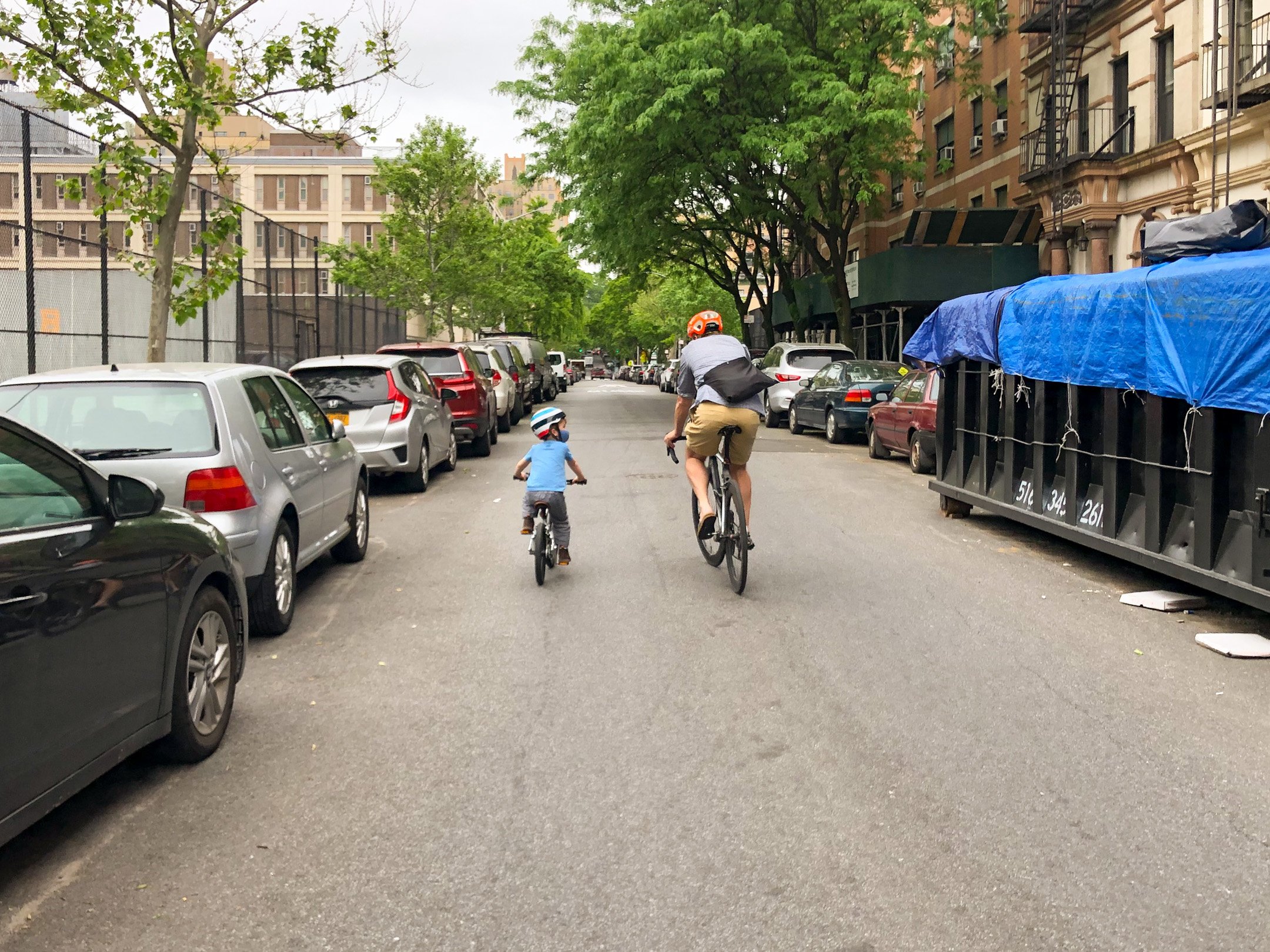Safe, successful, sustainable
Sharing the street with e-micromobility
NYC’s infrastructure is already behind in accommodating traditional cycling; adding the needs of e-micromobility has led to friction over this limited space. But the benefits will far outweigh the challenges, once we begin to adequately plan for their popularity.
Electric mobility devices are quickly changing New York City’s transportation landscape. They’re efficient, climate-friendly, convenient, accessible, and can replace more car trips than traditional bikes. They represent great potential, and have been especially transformative in the booming food delivery industry, where they make it possible for your food to be delivered much faster and from farther away.
However, the sudden addition of these devices has also changed the way our streets feel. Pedestrians may find e-bikes unpredictable; traditional cyclists may feel uncomfortable sharing a narrow bike lane with a faster rider. New York's bike infrastructure is already behind in accommodating traditional cycling; adding the needs of e-micromobility users has led to unnecessary but understandable friction over limited space. But the benefits of these devices will far outweigh the challenges, once we begin to adequately plan for their popularity.
Reactionary, reductive policies won’t cut it. New York City must pursue strategies that encourage a thriving, equitable e-micromobility culture while ensuring our streets still feel welcoming for pedestrians, traditional cyclists, and all other users. We must allocate much more space to micromobility and less to cars, educate everyone about sharing streets safely, and stop dangerous and illegal devices before they make it onto our streets. By proactively addressing the e-bike boom, New York City can alleviate tensions from sharing scant space and integrate e-micromobility into a larger landscape of safe, well-managed, people-centered streets.
Infrastructure
The most impactful thing we can do is allocate more space for micromobility of all kinds. It may sound counterintuitive to give more space to something that feels like it’s dominating the roadway (although cars – which are bigger, heavier, faster, and more dangerous than all micromobility – are the only thing actually dominating the streets), but that feeling is in large part due to current infrastructure not meeting our needs. Unpredictable behavior, like riding on sidewalks or riding the wrong way on a street, is a symptom of that gap between needs and reality. These behaviors are also illegal and create real danger for people. New York City must pursue a holistic approach to micromobility that creates adequate, well-designed space for everyone.
Vastly expand protected bike lane infrastructure in NYC, including creation of lanes specifically for e-devices.
Wider bike lanes, like the one recently installed on Ninth Avenue, allow for two lanes of bike traffic, just like a two-lane street for cars – slower riders, like those on traditional bikes, can comfortably ride in one lane while faster riders and e-devices can pass them safely in the other. This treatment unclogs bike lanes while ensuring everyone feels safe and comfortable. It also negates the need for e-bike users to circumvent a congested bike lane by riding on the sidewalk or into car traffic.
Every bike lane should be immediately adjacent to the sidewalk, with parking lanes (when they exist) between car lanes and bike lanes.
This will reduce the frequency of e-bikes on sidewalks, because delivery workers can use the bike lane to travel directly to the location of any delivery on a bike lane route. Where there is no bike lane, mid-block loading zones/access points can help ensure that delivery workers do not ride on the sidewalk. In all cases, DOT should work to create holistic streets that accommodate bikes along with other important curbside uses such as outdoor dining, bikeshare, trash containerization, commercial loading zones, and more.
Commit to designing every future bike lane as bi-directional and double wide.
Wrong-way riding is inevitable on small nimble devices, especially if food workers are on the clock to deliver orders; no one is going to go a long block out of their way. Legalizing this through infrastructure, and designing for it to be safe, will increase predictability for everyone. Pedestrians will know to look both ways when crossing the street, just as they do on a street with two-way motor vehicle traffic, and busy e-micromobility riders can rely on safe infrastructure that meets their needs.
Expand the number of busways in Manhattan.
Busways provide safe lanes for micromobility at all times when a bus is not present (a large portion of the time). Data from 14th Street before and after the creation of the busway showed dramatic safety improvements for all users, including those on micromobility. Compared to the four years before the 14th Street busway was fully implemented in October 2019, the following four years saw a 57% decrease in total injuries — 44% for cyclists, 46% for pedestrians, and 73% for motorists.
Implementing people-centered design for lower traffic neighborhoods would greatly increase the overall safety of our streets.
Corridors with high vehicle traffic make pedestrians feel vulnerable amid chaotic streets – the emergence of e-micromobility has heightened that feeling. But thoughtful design can slow traffic and make pedestrians feel that they have more safe space on streets and sidewalks, leading to less friction with micromobility and more feelings of comfort. DOT’s Street Improvement Projects, bike boulevards, traffic calming measures, and curb reform can all be impactful here.
Education
The public conversation around electric mobility is currently driven by a combination of misinformation, overreaction, and justifiable frustration. The tendency is to lump all e-micromobility together with blunt rhetoric and policy. But e-bikes are not mopeds; they don’t impact our streets in the same way and should not be treated as such. Attempting to regulate all e-micromobility with one broad stroke is misguided and will cause unnecessary barriers to ridership and employment for all users. Recent NYPD focus on seizing mopeds, an employment lifeline for many immigrant and migrant workers, illustrates this harm. Without point-of-sale regulation and careful education, we risk disproportionately harming vulnerable New Yorkers and creating new barriers to livability. New York City’s e-micromobility policies must encourage safe adoption and usage rather than hinder it.
But regardless of classification, all road users must share the space and act safely. Drivers of motor vehicles cause the vast majority of crashes on our streets — they account for 93% of pedestrian injuries and 99% of pedestrian deaths in the past year. However, it is essential to establish clear cultural norms around the use of electric devices. New Yorkers must feel safe crossing our streets and using our sidewalks, and unpredictable or illegal behavior by any vehicle jeopardizes that. Research shows that many e-bike users, especially those using the devices professionally, are new to cycling; they may need access to foundational information. Any attempts to create new policy and change behavior will hinge on users knowing, and following, basic rules for safety and care.
E-bike riders must understand that they should use bike lanes whenever possible and should never ride on the sidewalk. New York City should pursue ways to provide new e-bike riders with safety education to ensure they understand these and other rules of the road. PeopleForBikes recently launched E-Bike Smart, a course designed to help riders of all ages and experience levels learn best practices for safely and responsibly riding an e-bike.
Mopeds, however, are not allowed in the bike lane and create dangerous situations for users when they use the bike lane. These devices - which must legally be registered and have license plates - must use the vehicle lanes and follow all the rules that apply to cars and other motor vehicles. Retailers should play a role here providing this information to moped users at the time of purchase. Food delivery apps should also be required to provide education and training to their deliverers using e-bikes and mopeds.
Compliance with these rules is critical for the safety of all road users, and will hinge on cooperation from retailers, users, and City agencies.





Regulation
Ensuring that riders are using safe, legal vehicles begins at the point of sale. This approach addresses the issue at its root and is preferable to relying on policing, which can be discriminatory, ineffective, and would disproportionately affect hard-working Black and brown New Yorkers.
Many retailers are – knowingly or unknowingly – selling illegal devices, unsafe parts, or allowing purchasers to leave the site without required registration. Education among the public and within the industry can begin to address this issue and more firmly make the distinction between e-bikes, which do not require registration, and mopeds, which do. Yet New York City must establish clearer standards related to the sale of legal mopeds and e-bikes, demystify the purchasing and registration process, and prevent illegal devices or illegal behavior from endangering our streets.
Keep illegal mopeds off the road by enforcing against illegal and noncompliant businesses. Just as the DMV regulates car dealerships and can shut them down for noncompliance with laws, they should do the same for dealers of mopeds.
Ensure all businesses that sell mopeds are registered with the DMV and shut down any businesses that are not registered.
Shut down businesses that knowingly sell illegal devices, even if those businesses are registered with the DMV.
NYC Department of Consumer and Worker Protection should also be involved here, to ensure the consumer is protected from unscrupulous dealers.
Create clear standards for licensing and registration. The current rules around which devices need registration, and at what point during purchase, can be confusing to the user.
E-micromobility retailers should disclose to buyers, at the time of purchase, which types of devices require registration. Purchase should include information about the rules of the road (e.g., no riding mopeds in bike lanes, mopeds must follow traffic laws applicable to motor vehicles, etc)
Update New York State laws to require vehicle dealerships to ensure that all vehicles (both mopeds and cars/trucks) are registered and have a license plate before leaving the retailer
Pedal-assist and throttle e-bikes capable of reaching 25 mph must remain exempt from licensing and registration. Requiring e-bikes to have a license plate is unrealistic, would threaten access to popular pedal-assist CitiBikes and destroy employment opportunities for bike delivery workers. New York City’s e-micromobility policies must encourage safe adoption and usage rather than hinder it.
Require app companies to verify that devices used for delivery are legal and properly registered, as required by NYS law
Engage app companies as collaborators here, sharing knowledge about best practices
Explore opportunities to use app company’s purchasing power to financially support delivery workers procuring e-bikes or mopeds from a list of approved, legal retailers
Require app companies to provide training or other information about the rules of the road and safe usage
Battery Safety
Battery safety and infrastructure is a serious, albeit separate, issue from how e-micromobility impacts our experience of the streets. But the lack of public charging infrastructure is a burden to delivery workers and, as Streetsblog recently reported, has caused drivers to turn to polluting gas-powered mopeds for a solution. The anxiety around, and very real danger of, unsafe batteries also harms the potential for a larger adoption and mode shift. To address this, New York City must facilitate the safe purchase, disposal, and charging of batteries. This supporting policy will benefit all e-bike users and will especially help ensure that our delivery workers are using safe, legal, and speed-appropriate devices to deliver New Yorkers’ food.
Expand public charging stations in plazas, the periphery of parks, Citi Bike docks and other suitable areas.
Implement battery swap programs at small businesses and on public property, including sidewalks of certain width and in public plazas in neighborhoods with large delivery activity
Collaborate with Community Boards, property managers, universities, BIDs and other relevant organizations to ensure building and fire codes facilitate the installation of battery charging and fire suppressant infrastructure in buildings
Expand safe battery disposal sites to FDNY stations, DMVs, DSNY garages, Big Reuse, and other appropriate locations
Create manufacturing standards through the United States Consumer Product Safety Commission and better enforce against substandard batteries from overseas




